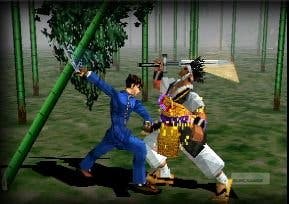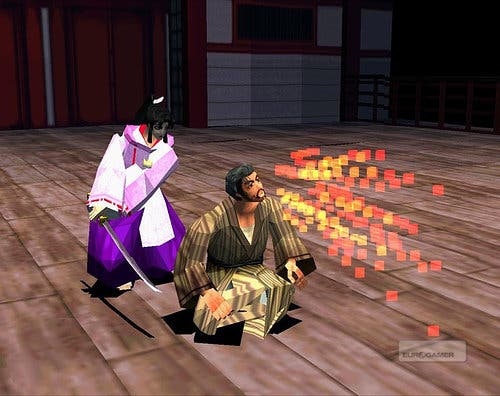Retrospective: Bushido Blade
There should be blood.
For those who realised what was going on, the 1997 release of Bushido Blade was a scary time. This was a fork in the road for fighting games. This title was taking a stand against everything we knew, and with luck it could have torn a rift in the entire genre. We watched Bushido Blade leap forward, beginning its attack. A bird took flight from a tree. The breeze stilled as we held our breath. All was silence.
Over the next year we watched Bushido Blade fail to muster the attention it should have - we saw the game drop its sword, fall to its knees, and cough out a crap sequel. That was that. All of Bushido Blade's training and secret techniques would be lost forever to the games industry.
And that hurt. Lord, it still hurts to this day. Every Tekken and Virtua Fighter brings a little soul-sting of what could have been. If one of your flatmates comes home to see you playing the new Soul Calibur and you notice the faintest hint of a tear forming in his eye, you know you're looking at a Bushido Blade fan.
Let me tell you what could have been.

Bushido Blade was a 'realistic' 3D weapon-based fighting game for the PSX with no health bars, and it's an idea realised with such confidence and ability that even today it's almost impossible to play Bushido Blade with a friend and not wonder how on earth health bars and combos became ubiquitous in fighting games and beat-'em-ups. Again, going back to Bushido Blade today what's also confusing is how developer LightWeight Co. managed to produce this and then follow it with as many as nine individual pieces of trash.
Bushido Blade works like this: If somebody scores a glancing blow on you, you're slowed. If somebody hits your arm, you fight on one-handed. If somebody hits your leg, you go down to one knee. If somebody hits you hard, anywhere at all, there is a horrible crunch or spurt of blood and you die.
You know, as if someone hits you very hard with a deadly weapon or something
So, you know how tense a fighting game gets when both of you only have a scrap of health left? That's Bushido Blade all the time!

And yeah, it's possible for any match to be over in three seconds, but that's less common and funnier than you'd expect. The characters in the game act with a distinctly human speed, and while most fighting games tend to funnel their complexity into aggression, Bushido Blade's depth all lies in dodging, staggering and blocking. This produces a game that's as much about waiting and cunning as it is about attacking, where knowing when to counterattack is as much about getting inside your opponent's head as reading his animations.
Advocates of more traditional fighting games might claim that's true of their chosen series, but it's just not. Those games all bear the millstone of being built for an arcade machine first and a home console second, and so they need to provide an instant thrill that lasts for at least 90 seconds. When a round of Bushido Blade starts the instinctive response is not to start spazzing about like a child riding the sugar high of a lifetime and go pummel your money's worth out of your opponent. The instinctive response from your very first match is to watch, and wait. Change your stance. Shuffle forward.








